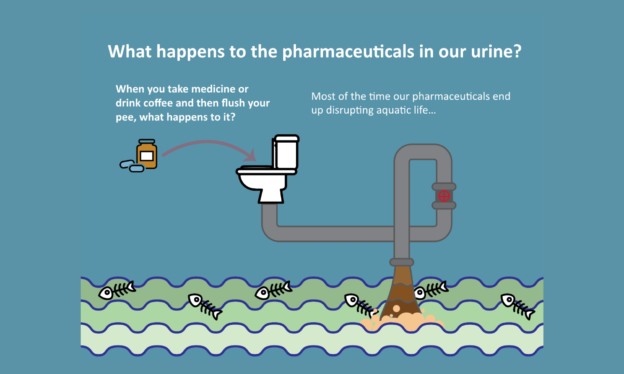Back to all articles
FAQ: Is urine fertilizer safe to use, given that urine can contain contaminants like pharmaceuticals and PFAS?

The short answer:
Some residual pharmaceuticals are present in urine, but soil microbes have a high capacity to degrade them, and controlled field trials have shown that consumers receive no significant exposure to pharmaceuticals from eating urine-fertilized crops. PFAS can be present in biosolids and other wastes at unsafe levels, but PFAS levels in urine are orders of magnitude lower, and rainwater adds more PFAS to farmland each year than does urine fertilizer. Activated carbon can be used as an additional measure to reduce the levels of PFAS and pharmaceuticals in urine, if a particularly cautious approach is required.
The details:
Micropollutants, including pharmaceuticals and PFAS, are a major focus of our research program. We conducted a multi-year study with the University of Michigan and University at Buffalo, funded by the US EPA and NSF, examining the fate of pharmaceuticals when urine is used to grow food crops. We are now engaged as the lead organization in a 5-year study that includes quantification and management of PFAS in both source-separated human waste and sewage sludge.
Pharmaceuticals have lives of their own once our bodies are done with them. Any medications and drugs we take or coffee we imbibe each morning enter our bloodstream, are filtered out by our kidneys and digestive system, and ultimately excreted in the form of both urine (~64%) and feces (~35%). When people use conventional sanitation systems, the pharmaceuticals flow to a wastewater treatment plant or a septic system. These wastewater management systems were designed with the primary purpose of controlling the spread of pathogens (biological disease-causing agents) and neither is very good at removing the plethora of chemicals that we send their way. Many pharmaceutically active compounds travel through these systems largely unchanged, which is why pharmaceuticals are commonly detected in aquatic ecosystems.
Pharmaceuticals have various disruptive effects on aquatic species–from disorienting eels, to emboldening crayfish, to causing shrimp to swim toward the light. Pharmaceuticals in waterways can also enter drinking water sources for human communities, with largely unknown effects. By collecting urine and/or micro-flush toilet water and keeping it out of the wastewater stream, we can contain the pharmaceuticals before they reach sensitive aquatic ecosystems and water supplies.
When urine is applied to agricultural soil, there is an opportunity for the diverse community of soil microbes to break down and degrade the residual pharmaceuticals, over a period of weeks. In contrast, it takes about a day for wastewater to pass through a treatment plant and enter the receiving river or lake. Our own as-yet-unpublished research results from a laboratory soil incubation study show dramatic reduction of common pharmaceuticals (to the point of non-detection) after just a few weeks. So, perhaps surprisingly, applying urine to cropland can control pharmaceuticals better than flushing them downstream, with clear benefits to environmental health.
But that raises new questions, including whether these pharmaceuticals end up in edible crops and how they might affect long-term soil health. These are some of the most common concerns that people have raised about urine as fertilizer. The Rich Earth team has done substantial work to better understand these questions.
Our pharmaceutical research
From 2014-2020, Rich Earth conducted multiple field and lab trials looking at the fate of pharmaceuticals in urine, in partnership with the University of Michigan, the University at Buffalo, and the Hampton Roads Sanitation District. Specifically, we studied the presence and persistence of pharmaceuticals in urine-derived fertilizers, soils, groundwater, and crop tissues.
We have tested 20 different pharmaceuticals and 2 metabolites. In the final year of research we also added 3 natural hormones (estrone, estradiol, and estriol), and one synthetic hormone (ethinylestradiol), for a total of 26 different compounds. These pharmaceuticals and metabolites were chosen to represent a diversity of types of medication as well as a variety of chemical properties. The amounts and concentrations used were based on the highest levels that has been found in a community wastewater system, based on the scientific literature.
Our research has consistently found that while there are some pharmaceuticals detectable in crop tissue, the levels are extremely small–in the nanogram per gram (or parts per billion / ppb) range. We have not detected any hormones in plant tissue. This academic paper with results on pharmaceutical levels in plant tissue, and these two academic posters outlining methods and results provide information about this study of pharmaceutical levels in soil, water, and plants, and an additional paper is in process.
Unsurprisingly, caffeine was the most abundant drug found in human urine. But the molecule is present in such tiny amounts in urine-fertilized lettuce that you would have to eat over 4,000,000 salads (made with 85 grams of lettuce) to ingest as much caffeine as is present in a 16 oz cup of coffee. (For details and references, see the supporting “Pharmaceutical Overview” document submitted along with these answers.) This would be impossible to achieve in a human lifetime. Other drugs were present at even lower levels. (We use lettuce as an example because it represents a worst-case scenario, since pharmaceuticals are carried to the leaves and concentrated there when water from the roots flows into the leaves and then evaporates).
It is important to note that much of grocery-store produce (including organic) is grown on land fertilized with animal manures, which often contain residues from pharmaceuticals given to livestock. Additionally, treated wastewater plant effluent, with its pre-existing pharmaceutical loads, is used for irrigation (common in arid climates, including on organic farms). Other researchers have looked at the fate of pharmaceuticals in these situations, and have found results similar to ours: pharmaceuticals are sometimes taken up by crops, but in extremely small amounts, in the nanogram per gram (ng/g) range. Wastewater irrigation results in somewhat higher uptake levels, perhaps because it usually involves repeated applications closer to harvest time. Still, at this point, our understanding is that the scientific literature indicates these quantities do not represent a significant risk to human health.
PFAS
PFAS contamination of farm soil is now recognized as a major problem, with effects on food safety and farm viability. This contamination is the result of decades of land application of sewage and industrial sludges, without consideration of the PFAS that they have contained, which in some cases have been extreme. The PFAS levels in these sludges is highly variable, depending on what sort of waste the sludge is derived from. Paper mill sludge is notorious for PFAS contamination, due to PFAS chemicals sometimes used in the papermaking process. Wastewater sludge (aka biosolids) can have much higher or lower levels of various PFAS compounds, depending on whether the wastewater plant accepts PFAS-laden leachate from landfills, industry, or other contaminated sources.
Biosolids were long promoted as a beneficial way to capture some of the nutrients from wastewater (the majority of which come from urine), and return them to agriculture. Unfortunately, in addition to nutrients, biosolids also contain residual contamination from every waste product that enters the wastewater system. This can include industrial waste containing PFAS, heavy metals, PCBs, and other contaminants. In the U.S., many states are now tightening regulations around biosolids, with the states of Maine and Connecticut recently going as far as to ban the application of biosolids because of PFAS contamination.
Source-separation of urine, followed by recycling into fertilizer, is the simplest and most direct way to capture and reuse the nutrients from our bodies, before they are irreversibly mixed with other contaminated wastes. Published research bears this out, with PFAS levels in urine typically below the limits set in the U.S. for drinking water. Notable exceptions involve studies of individuals exposed to very high levels of PFAS contamination, for example by using a drinking water supply that was contaminated with aqueous film firefighting foam (AFFF).

